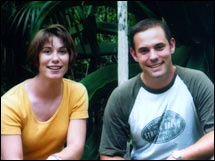
NEW YORK (CNN/Money) - Brad and Sharon Oldham are trying to stay ahead of the game.
Brad, 29, bought his first home for $155,000 in 1999 through a lease-to-buy program offered by a Dayton-area developer to stimulate sales in a new subdivision. At the time, Brad was leasing an apartment owned by the developers. As part of the agreement, 50 percent of his rent, or $350 a month, went towards the downpayment.
That move helped him build equity at a young age while ensuring his rent payments weren't going to waste. He recently sold the home for $177,500 to trade up to his current house.
Smart financial planning and a thrifty lifestyle have allowed Brad and his wife to slowly build their net worth. Now, after only four years of marriage, the pair is worth $235,925 and counting.
Budget not blow
Not many twenty and thirty-somethings are keen on budget living, but the Oldhams see it as a way for them to track their spending.
"Every dollar that we spend, we know where it is going," says Brad. "People make fun of us because we write everything down."
Brad doesn't recall his parents budgeting their expenses, but he says they introduced him to the idea just before he moved out on his own.
Sharon, 32, became interested in budgeting after moving back to the area from Virginia in 1997. Up to that point, she lived paycheck-to-paycheck and was tired of having nothing to show for it.
"I knew that I had to start saving if I wanted to have more than a one-bedroom apartment," Sharon says.
The couple regularly sets aside $450 a month for their cash savings, which they also use to make contributions to their IRAs.
Don't think, however, that the Oldhams are all work. The two also stash away $200 a month for vacation and hope to return to Kaui, where they honeymooned, to celebrate their fifth wedding anniversary.
"We tend to splurge on big things like vacations," says Brad. "But day-to-day, we live fairly simply."
One of their biggest rules is to buy things on sale, be it clothes or groceries. Brad is a self-confessed bargain shopper who likes to hunt for the best deals. Living near an outlet mall makes bargain shopping easier.
Also, the two use their Discover cards for everyday purchases in order to take advantage of the credit-card company's cash back program. But they are sure to pay off their balance each month.
Brad also uses his Discover card for business expenses and his company lets him keep any cash back awards. He usually receives a cash-back credit in December while Sharon's card lets them redeem points at local merchants such as Red Lobster and Borders.
Adding it all together
Brad and Sharon moved into a new home in April, using the equity gained from the sale of their first home for part of the $70,000 downpayment. It's a bigger mortgage, $290,000, but they scored a 5.5 percent 30-year fixed-rate loan.

The pair is hoping for a retire in their 50s, so long-term planning is one of their biggest financial goals. They contribute the yearly maximum of $3,000 to their Roth IRA accounts by making lump sum payments. The advertising agency where Brad works as an account executive cut its 401(k) matching program, but he continues to contribute $450 a month.
Sharon is an animal adoption administrator at a local humane society but her job does not offer a retirement savings program. Her employer may soon offer a 403(b) retirement program, a defined contribution plan specifically for non-profit organizations.
| More Millionaire Profiles
|

|
|
|
|
She also worked with Brad at the ad agency before leaving to take a job as an animal-adoption administrator, so she was able to set aside some cash in a 401(k) account, which she later rolled over to an IRA.
The Oldhams are big on mutual funds, with their $59,400 in retirement savings split among Vanguard, Thrivent, and Fifth Third. They have another $64,400 invested in taxable accounts, including a healthy stake in Treasury bonds.
They are avid savers, with $30,800 in their checking and savings accounts, a move which Brad says has a lot to do with their conservative upbringing. But with rates as low as they are, they're eyeing other investment options.
Brad inherited some art from his grandfather, with an estimated value of $3,225. Brad also owns a baseball memorabilia collection, which he bought at his uncle's garage sale for $3 when he was 13 years old. Today, its estimated value is about $6,000. Among his more valuable finds: two Mickey Mantle cards from 1953.
With no consumer debt, not even a student or car loan, the two are on track to reach their dreams.
"I feel pretty good about the care we are taking in planning for our future," Sharon beams.

|

